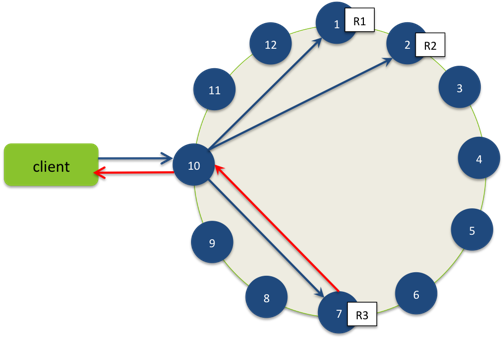Certify and Increase Opportunity.
Be
Govt. Certified Apache Cassandra Professional
Data Read and writes
All nodes in Cassandra are peers. A client read or write request can go to any node in the cluster. When a client connects to a node and issues a read or write request, that node serves as the coordinator for that particular client operation.
The job of the coordinator is to act as a proxy between the client application and the nodes (or replicas) that own the data being requested. The coordinator determines which nodes in the ring should get the request based on the cluster configured partitioner and replica placement strategy.
For writes, the coordinator sends the write to all replicas that own the row being written. As long as all replica nodes are up and available, they will get the write regardless of the consistency level specified by the client. The write consistency level determines how many replica nodes must respond with a success acknowledgement in order for the write to be considered successful.
For example, in a single data center 10 node cluster with a replication factor of 3, an incoming write will go to all 3 nodes that own the requested row. If the write consistency level specified by the client is ONE, the first node to complete the write responds back to the coordinator, which then proxies the success message back to the client. A consistency level of ONE means that it is possible that 2 of the 3 replicas could miss the write if they happened to be down at the time the request was made. If a replica misses a write, the row will be made consistent later via one of Cassandra’s built-in repair mechanisms: hinted handoff, read repair or anti-entropy node repair.
In multi data center deployments, Cassandra optimizes write performance by choosing one coordinator node in each remote data center to handle the requests to replicas within that data center. The coordinator node contacted by the client application only needs to forward the write request to one node in each remote data center.
For reads, there are two types of read requests that a coordinator can send to a replica; a direct read request and a background read repair request. The number of replicas contacted by a direct read request is determined by the consistency level specified by the client. Background read repair requests are sent to any additional replicas that did not receive a direct request. Read repair requests ensure that the requested row is made consistent on all replicas.
Thus, the coordinator first contacts the replicas specified by the consistency level. The coordinator will send these requests to the replicas that are currently responding most promptly. The nodes contacted will respond with the requested data; if multiple nodes are contacted, the rows from each replica are compared in memory to see if they are consistent. If they are not, then the replica that has the most recent data (based on the timestamp) is used by the coordinator to forward the result back to the client.
To ensure that all replicas have the most recent version of frequently-read data, the coordinator also contacts and compares the data from all the remaining replicas that own the row in the background, and if they are inconsistent, issues writes to the out-of-date replicas to update the row to reflect the most recently written values. This process is known as read repair. Read repair can be configured per column family (using read_repair_chance), and is enabled by default.
For example, in a cluster with a replication factor of 3, and a read consistency level of QUORUM, 2 of the 3 replicas for the given row are contacted to fulfill the read request. Supposing the contacted replicas had different versions of the row, the replica with the most recent version would return the requested data. In the background, the third replica is checked for consistency with the first two, and if needed, the most recent replica issues a write to the out-of-date replicas.
Apply for Apache Cassandra Certification Now!!
http://www.vskills.in/certification/Certified-Apache-Cassandra-Professional


